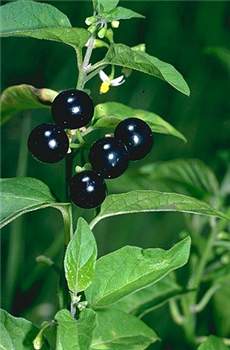
Synonymy
Solanum americanum Miller, Gard. Dict. 8th edn, no. 5 (1768)
T: Cultivated Chelsea Physic Garden, origin Virginia, North America, Miller s.n.; lecto: BM, fide J.M. Edmonds, J. Arnold Arbor. 52: 634 (1971), photo AD.
S. nodiflorum Jacq., Collectanea 2: 288 (1789) & Icon. Pl. Rar. 2: 11; t. 326 (1789).
T: Cultivated Vienna, origin Mauritius, Herb. Jacquin; lecto: BM, fide R.J.F. Henderson, Contr. Queensland Herb. 16: 28 (1974).
S. nodiflorum subsp. nutans R. Henderson, Contr. Queensland Herb. 16: 30; t. 2 (1974).
T: Indooroopilly, Qld, Apr. 1969, R.J.F. Henderson 518; holo: BRI 86633; iso: K, MEL, NSW.
[S. nigrum auct. non L.; G. Bentham, Fl. Austral. 4: 446 (1869) p.p.]
Description
Erect or spreading herb or short-lived perennial shrub to 1.3 m, glabrous or sparsely pubescent with simple hairs, green or the stems and leaves often purplish; prickles absent. Stems often angled or narrowly winged.
Leaves ovate or ovate-lanceolate; lamina 212 cm long, 17 cm wide, concolorous, entire or shallowly lobed; petiole 14 (occasionally to 9) cm long.
Inflorescence short, 412flowered; peduncle to 25 mm long, lengthening to 45 mm in fruit; pedicels 58 mm long. Calyx 12 mm long; lobes rounded, 0.41.2 mm long. Corolla deeply incised, usually 89 mm diam., white or flushed purple with yellow-green centre. Anthers 1.52 mm long.
Berry globular, 69 mm diam., purple-black. Seeds 11.5 mm long, light fawn or purplish; stone-cell granules, if present, c. 0.5 mm diam. n=12.
Distribution and ecology
A variable cosmopolitan weed in tropical and warm temperate regions. Usually grows in disturbed habitats associated with human activities.
Occurs mainly in coastal areas of eastern Qld and N.S.W., where possibly indigenous or of pre-European introduction, and in scattered localities in Vic., W.A. and N.T. where naturalised from later introductions. Also on Lord Howe Is.
Common name
Glossy Nightshade.
Relationships
Part of the S. nigrum or "Black nightshade" group of species, usually referred to as cosmopolitan weeds and usually thought to have originated in the Americas. They are characterised by their lack of prickles and stellate hairs, their white flowers and their green or black fruits arranged in an umbelliform fashion.
The species can be difficult to distinguish. Other species to occur in Australia are S. chenopodioides, S. douglasii, S. furcatum, S. nigrum, S. opacum, S. physalifolium, S. retroflexum, S. sarrachoides, S. scabrum and S. villosum.
Notes
A useful reference to the Black Nightshades is J. M. Edmonds & J. A. Chweya, The Black Nightshades. Solanum nigrum and its related species. Int. Plant. Genetic Res. Inst. Rome (1997). This can be downloaded from www.ipgri.cgiar.org/publications/pdf/337.pdf
There has been some disagreement as to the correct name for this species; it was previously called S. nodiflorum Jacq. in much Australian literature - recent work using African material has shown that their material under this name is deserving of species status.
Reference: M.L.K. Manoko, R.G. van den Berg, R.M.C. Feron, G.M. van der Weerden & C. Mariani (2007). AFLP markers support separation of Solanum nodiflorum from Solanum americanum sensu stricto (Solanaceae). Pl. Syst. Evol. 267: 111. Downladable at www.springerlink.com/content/gmm700927409465h/fulltext.pdf
This species is extremely widespread throughout warm temperate and tropical areas. In Africa, New Guinea and Oceania the young green shoots are cooked and eaten as greens.
Some members of the complex have long been important food and medical sources in parts of Africa,
References: Keller, G.B. (2004). African nightshade, eggplant, spiderflower et al. - production and consumption of traditional vegetables in Tanzania from the farmer's point of view. MSc dissertation,
Selected specimens
W.A.: South Perth, R.D. Royce 8408 (PERTH). N.T.: Adelaide River, 22 Nov. 1972, J. Holmes (DNA, NT). Qld: Belmont, S.L. Everist 5606 (BRI). N.S.W.: Kogarah, E.F. Constable 5633 (NSW). Vic.: E of Marlo, 7 Feb. 1972, J.H. Willis (MEL).
From the web
Images of S. americanum can be accessed through the description of this species in Bean's interactive key at http://delta-intkey.com/solanum/www/american.htm
Further information and images of this species in NSW can be seen on the PlantNET site for WA on the FloraBase site and for SA on the eFlora site.
Images and information on this species in California can be accessed through the Encycloweedia pages at www.cdfa.ca.gov/phpps/ipc/weedinfo/solanum-americanum2.htm or www.cdfa.ca.gov/phpps/ipc/weedinfo/solanum-americanum.htm and in Missouri at www.missouriplants.com/Whitealt/Solanum_americanum_page.html
Further information on this species in
A comprehensive fact sheet on S. americanum in
Work on African material using AFLP markers has supported the recognition of a separate species for material previously treated under either S. americanum or as a separate species, S. nodiflorum.
Reference: M.L.K. Manoko, R.G. van den Berg, R.M.C. Feron, G.M. van der Weerden & C. Mariani (2007). AFLP markers support separation of Solanum nodiflorum from Solanum americanum sensu stricto (Solanaceae). Pl. Syst. Evol. 267: 111. Downladable at www.springerlink.com/content/gmm700927409465h/fulltext.pdf


